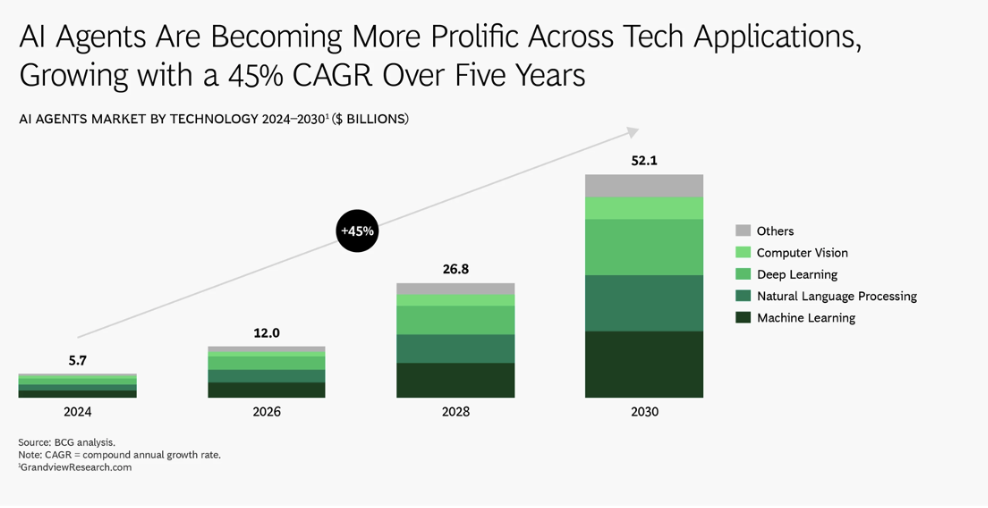By Shashank Mahajan, MBA Student at Kellogg School of Management
The pace of technological progress has always been astounding, but this year, it’s been utterly humbling, especially for anyone trying to keep up with AI. The signal-to-noise ratio around AI is not only overwhelming but often biased toward the ‘deep research’ headlines from labs like Anthropic, whose recent work on mapping the “mind” of language models is reshaping our understanding of how these systems internalize concepts [1]. Apple recently published in its research how the reasoning models are bounded by their nature as token predictors – which places an upper limit on how much reasoning they can truly achieve [2]. Other Big Tech are rolling out ever more advanced models and features — many of which are still months away from real-world use. It’s easy to overlook the quieter, more immediate revolution: how AI is actually being applied across industries today.
While this article does not attempt to uncover every possible AI adoption trend, it focuses on some of the most compelling, high-impact ways AI is being put to work — especially in spaces where operational efficiency, agility, and strategic automation are quickly turning into competitive advantages.
You know it’s the Middle Market when you see the highest AI growth trends
With AI growing exponentially, interesting patterns are emerging specifically in the middle market space. As tech giants rapidly invest in AI, businesses in the middle markets that are utilizing AI for productivity gains are reaping the advantages. These businesses are not just experimenting with AI anymore, they are investing substantially, thus reflecting the belief they have put in the future of AI. The rapid decision making associated with these companies gives us a reason to believe that efficiency in capital deployment stands in stark contrast to the massive, often bureaucratically encumbered technology investments made by larger organizations. With AI democratization, Small Medium Enterprises (SMEs) are not limited to high quality talent and, instead, can utilize platforms such as Cohere to customize AI for niche use cases, from optimizing supply chains to generating hyper-localized marketing content while maintaining compliance. Research indicates such implementations drive between 27% and 133% of productivity gains in SMEs, particularly in service sectors where streamlined workflows directly enhance competitiveness [3].
Operational improvement is underrated
Flashy robot demos and Sora’s lifelike videos might grab headlines, but AI’s biggest ROI is still in the back office. The AI democratization aligns with broader trends: 60% of SMEs plan to boost AI spending in 2025 and prioritize targeted applications that yield rapid ROI. AI driven service desks, cash flow predictions, and inventory management for carry cost reduction might not sound as sexy, but are helping organizations achieve unprecedented efficiency, accuracy, and cost savings. For instance, on the supply‑chain side, Bendi.ai’s Prism platform pre‑fills vendor questionnaires and flags sourcing hotspots in minutes, collapsing weeks of manual due‑diligence into a dashboard. These frontiers are paving the way for cost centers to transform into strategic assets, with AI orchestrating the emergence of “services as software” in the race to automate administrative workflows [4]. Security is another back‑office cost center quietly evolving into a critical driver of business value. Montréal‑based CyberDefense.ai runs an autonomous, AI‑driven firewall that blocks 98% of common exploits in real time and auto‑generates compliance evidence to eliminate hours of manual rule‑writing and audit prep. Conversations with CEOs on the Industrials side demonstrate a growing interest in employing machine learning for their back-office, day-to-day tasks, which might be as simple as automated invoice generation, or as typical as coming up with pricing strategies for products.
Agentic AI is taking the world by a storm
AI’s edge lies in its ability to not only recommend actions, but also autonomously execute them, transforming decision-making processes across industries. While Large Language Models have been trending since 2022, Agentic AI is having its own moment, especially in 2025. Have you ever wondered what all the Twitter buzz about Model Context Protocol (MCP) has been? Anthropic’s release of MCP [5] marked a defining moment for inter-agent interactions, specifically for tools that, on top of providing recommendations, can now also take actions. Have you ever considered the possibility of outsourcing the task of creating a cart on Instacart [6] based on an ingredient list from ChatGPT? This is where the MCP architecture comes into play, with Agents (like OpenAI’s Operator) orchestrating decision-making to action-taking work so that you can get that extra 10 minutes at the gym (you can only flex until humanoids steal that spotlight).

Startups such as Levee and Oraczen are translating agentic architecture from consumer chatbots to gritty, day‑to‑day operations. Agentic patterns aren’t just for e‑commerce carts as demonstrated by Levee which is innovating hotel operations through data capture using video and audio. Levee’s AI agents augment housekeeping staff by monitoring every guest room during their visits, helping to prioritize issues and take action — whether by reprioritizing housekeeping routes or opening work orders — without needing a manager’s involvement.
What VCs are looking for
With VCs growing wary of startups exaggerating the use of AI to attract funding, Builder.AI being a recent example [7], one space that does get VCs interested may be plain old operational efficiency improvements. Google Cloud posits that leading VCs want AI “integrated into core business functions, automating repetitive tasks to improve operational efficiencies and enhancing decision-making among knowledge workers”. Startups must integrate AI into their core offerings to aid decision-making, extend their runway, and reduce burn rates in uncertain market conditions. AI-powered tools are enabling startups to optimize resource allocation, streamline supply chains, and enhance customer experiences, ultimately boosting profitability and operational scalability. These trends underscore investors’ growing emphasis on startups’ capital management to keep up with the current funding environment [8] [9]
You heard that right! Traditional industries are back
AI is now reshaping industries that may previously have been considered resistant to technological disruption, with Agriculture, Manufacturing and Hard Tech gaining traction. Reactive and preventative maintenance are losing their vigor to predictive maintenance – the new kid in town. The real-time insights from predictive maintenance allow for a far superior maintenance cycle, putting an end to cost inefficiencies and resource wastage while maximizing equipment lifetime [10]. Concepts such as Digital Twins, that primarily found their use case in Aerospace, are further disrupting the Manufacturing industry by analyzing real-time data to perform predictive maintenance, monitor product lifecycle, and identify bottlenecks. 1871’s portfolio startup CropMind is bringing predictive‑maintenance logic to orchards, using AI‑driven computer‑vision twins of each tree to forecast yield, detect disease and guide interventions in real time, saving growers both chemicals and labor. Additionally, platforms such as MetAI are giving a glimpse of AI-powered technology frameworks that use synthetic data to enhance the accuracy of digital twins while allowing manufacturers to fine-tune processes. CEOs in traditional industries have all the right to be wary about AI disruption — they not only need to prepare their teams for widespread adoption, but must become comfortable using AI themselves.
AI in preventative medicine is not losing steam either
For the past few years, classification has been a frontier where healthcare has been adopting machine-learning and AI capabilities for making effective X-rays and ultrasound diagnosis [11]. Much like predictive maintenance for manufacturing, AI is now entering a new territory of prediction in healthcare — a foray into proactive and preventive care [12]. Multiple data sources, including your genetic data, wearable device data and lifestyle data, can be efficiently analyzed by predictive models to make more accurate forecasts about future health outcomes. From prescribing personalized treatment plans for cancer patients, to creating 3D models of a patient’s coronary arteries to identify blockages, startups in healthtech are embracing AI to predict health events before they occur, thus optimizing chronic disease management and reducing healthcare costs.
AI has now invaded every link of the value chain, from the back‑office inbox you dread opening, to housekeeping tasks for hotels. Data‑infrastructure, physical ops, and even deep‑tech R&D are now getting their own purposeful AI layer. AI is transitioning from a fringe innovation to a practical tool increasingly embedded in the core of business operations. The winners will be the leaders who can spot these vertical needles in the AI haystack, deploy them early, and let the flywheel of data‑driven improvement do the rest.
Join as an 1871 Early Stage Member.
Attend info sessionSubscribe to our ICYMI newsletter.
Share this post:
